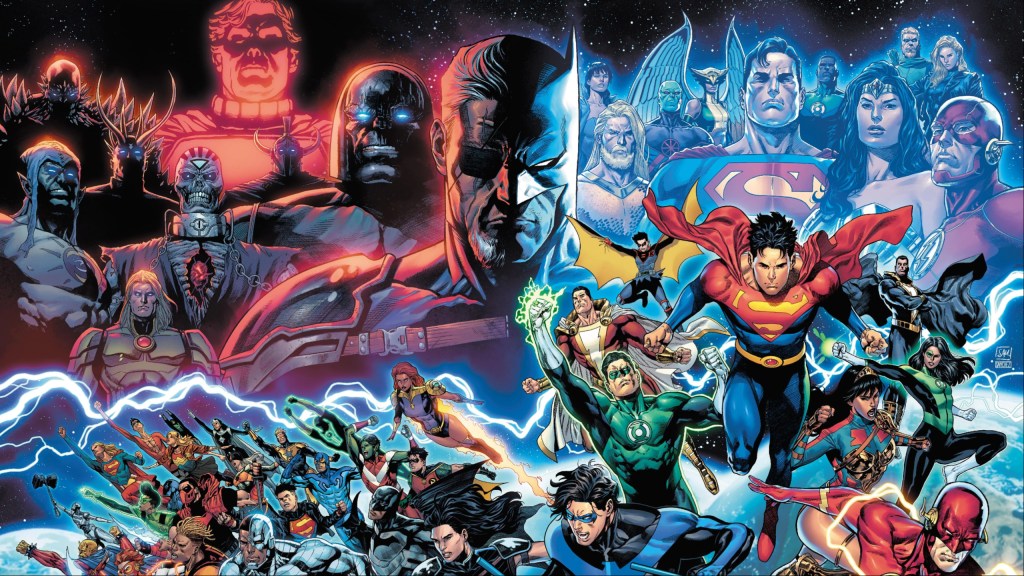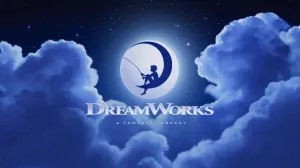DC Comics is going through something of a renaissance lately. While the publisher still hasn’t taken Marvel’s place at the top of sales charts, the success of the Absolute line has made a lot of fans remember just how much they love DC and its characters. DC’s “All-In” publishing initiative is giving readers great superhero comics, but DC fans have been getting great stories for several now, with the “Dawn of DC” publishing initiative starting the upward trend that DC has been on. “Dawn of DC” came after “Infinite Frontier”, a publishing initiative that doesn’t have the best reputation and which ended with a story that is definitely underappreciated by fans — Dark Crisis on Infinite Earths, by Joshua Williamson and Daniel Sampere.
Videos by ComicBook.com
Dark Crisis on Infinite Earths plays into several tropes of DC events that many fans are somewhat tired of — multiversal shenanigans and yet another story that plays off the events of the DC classic Crisis on Infinite Earths. The story isn’t as beloved as what came before, with many fans not really giving it any respect. However, Dark Crisis on Infinite Earths is much better than it gets credit for, paving the way for all of DC’s success in the last few years.
Dark Crisis on Infinite Earths Is Everything that DC Does Well in One Story

Dark Crisis on Infinite Earths‘ build up was kicked off in Infinite Frontier, the series named after the post-Dark Knights: Death Metal publishing initiative. “Infinite Frontier” isn’t given a lot of praise and for good reason; DC had to pull back their publishing line because of lack of sales, and made up the shortfall with multiple Batman miniseries and one-shots. Infinite Frontier started revealing there was something happening out in the multiverse, with even Darkseid being pulled into the situation. This led to Justice League Incarnate, as the heroes of the multiverse teamed together to battle a mysterious new threat, one which was revealed to be the Great Darkness, a force of oblivion created by Alan Moore during his landmark Swamp Thing run.
This all led to Dark Crisis on Infinite Earths, first named Dark Crisis. Fans weren’t at all excited for this new story. To begin with, there was DC again taking an Alan Moore idea, dusting it off, and putting it forward in a major DC event. The Great Darkness didn’t really need to come back, in most fans’ opinion, and it didn’t really fit as a villain anyway, since it wasn’t a being but rather an embodiment of the concept of entropy. The next problem for a lot of fans was the “Crisis” name. Stories with the name “Crisis” in it became shorthand for yet another multiverse story, something that most readers figured would be done after Death Metal, which brought back the infinite multiverse as the Omniverse. On top of that, it was revealed that Pariah, a character from the original Crisis, was the other main villain of the story, another nail in the book’s coffin.
RELATED: This Was the Best Vertigo Comics Series (And You Won’t Change My Mind)
Dark Crisis on Infinite Earths revolved around several plots. The “death” of the Justice League in the lead-up to the story meant that the heroes were without their leaders, just as Deathstroke starts attacking the heroes with an army of C-list villains. Deathstroke was put up to this by Pariah, as both of them want to destroy all existence because of their pain, the two of them working together to call on the Great Darkness to hasten the end. It’s a pretty simple story, with the heroes — and later the Legion of Doom — falling before Deathstroke’s army as Pariah worked outside of the multiverse to help the whole situation along. Dark Crisis on Infinite Earths‘ ending saw the return of the Justice League and them handing off their role to the Titans, the defeat of Deathstroke and Pariah, and the recreation of the infinite multiverse… which readers had thought they had just gotten.
I’ll be first to admit that Dark Crisis on Infinite Earths‘ plot isn’t exactly the best. It’s exactly what one would expect from a DC event. Dark Crisis on Infinite Earths was a retread of what came before in many ways, but reading the book reveals an actual great story, especially if readers were picking up the tie-ins, miniseries, and one-shots. It’s a much more fun story than it gets credit for, with great art, awesome moments, and some deft character work. Dark Crisis on Infinite Earths isn’t the deepest event story, and it’s extremely trope-y, but that doesn’t mean that it’s not a great read. The seven issue series is a showcase of everything that DC does well, and it led to the biggest DC stories in years.
Dark Crisis on Infinite Earths Laid the Groundwork for DC’s Current Success

Dark Crisis on Infinite Earths felt like another multiversal reboot that wasn’t really needed, following Death Metal as it did, but looking at what came after it shows just how important the story is to modern DC. Bringing back the infinite multiverse in a “Crisis” story, one that played into the concept of legacy that DC does better than anyone else, is what led to the back to basics approach that “Dawn of DC” used so well. Everything was reset to a classic status quo for the characters, allowing readers who had left because of DC’s multiple continuity reboots over the last twenty years, and that wouldn’t have been possible without Dark Crisis on Infinite Earths.
Going backwards isn’t always the best idea in superhero comics. The success of the Absolute line — and Marvel’s newest Ultimate line — shows that fans want new stories from superhero comics. However, DC had put its superhero universe into a very confusing place in the years before Dark Crisis on Infinite Earths, and they truly needed a reset that would take all of that away. Dark Crisis on Infinite Earths gave the publisher that, and it did it in the best way possible, by reminding people what they used to love. Seriously, go give Dark Crisis on Infinite Earths another read, knowing where the publisher has gone since, and you’ll find a story that is way better than it gets credit for.








